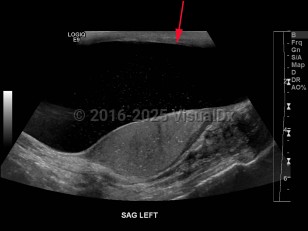Hydrocele of testis
Alerts and Notices
Important News & Links
Synopsis

A hydrocele is an accumulation of serous fluid between the visceral and parietal layers of the tunica vaginalis, which covers the testes and spermatic cord. Hydroceles may be communicating or noncommunicating. A communicating hydrocele results from failure of closure of the tunica vaginalis leaving a patent process. This is most common in newborns. The fluid is often reducible. Noncommunicating hydroceles have no connection to the peritoneal cavity and are not reducible.
A hydrocele often presents as a painless visible or palpable cystic mass in the scrotum and otherwise is usually asymptomatic.
Typically, a male newborn patient presents with painless scrotal swelling on one or occasionally both sides. Usually, the hydrocele will go away on its own within the first year of life without medical intervention. An adult man who presents with a hydrocele may experience discomfort, a feeling of heaviness or fullness, or induration and irritation of the scrotal skin.
Hydroceles will present bilaterally only in a small minority of patients. Size and palpability may vary depending on patient position (lying down, standing up, etc). When located on the right side of the body, hydroceles are often associated with hernias.
A congenital hydrocele results from a process during embryogenesis where the processus vaginalis remains patent, allowing fluid from the peritoneum to accumulate in the scrotum. Most hydroceles are present at birth, and approximately 1%-2% of newborns may present with a hydrocele. Patients who are born prematurely are at increased risk.
An adult-onset hydrocele may occur due to scrotal inflammation resulting from epididymo-orchitis, tuberculosis, or tropical infection. Older boys and adult men may also develop a hydrocele as a result of scrotal injury. Risk factors also include sexually transmitted infections (STIs). In adults, patients older than 40 years are most commonly affected. While hydroceles are typically benign and usually do not affect fertility, they can be associated with other serious conditions of the testes such as infection, tumor, or inguinal hernia. Almost all acquired hydroceles improve with resolution of the causal etiology.
Most hydroceles resolve on their own during the first year of life. Surgical resection can be considered for infants or adults with persistent, symptomatic hydroceles.
A hydrocele often presents as a painless visible or palpable cystic mass in the scrotum and otherwise is usually asymptomatic.
Typically, a male newborn patient presents with painless scrotal swelling on one or occasionally both sides. Usually, the hydrocele will go away on its own within the first year of life without medical intervention. An adult man who presents with a hydrocele may experience discomfort, a feeling of heaviness or fullness, or induration and irritation of the scrotal skin.
Hydroceles will present bilaterally only in a small minority of patients. Size and palpability may vary depending on patient position (lying down, standing up, etc). When located on the right side of the body, hydroceles are often associated with hernias.
A congenital hydrocele results from a process during embryogenesis where the processus vaginalis remains patent, allowing fluid from the peritoneum to accumulate in the scrotum. Most hydroceles are present at birth, and approximately 1%-2% of newborns may present with a hydrocele. Patients who are born prematurely are at increased risk.
An adult-onset hydrocele may occur due to scrotal inflammation resulting from epididymo-orchitis, tuberculosis, or tropical infection. Older boys and adult men may also develop a hydrocele as a result of scrotal injury. Risk factors also include sexually transmitted infections (STIs). In adults, patients older than 40 years are most commonly affected. While hydroceles are typically benign and usually do not affect fertility, they can be associated with other serious conditions of the testes such as infection, tumor, or inguinal hernia. Almost all acquired hydroceles improve with resolution of the causal etiology.
Most hydroceles resolve on their own during the first year of life. Surgical resection can be considered for infants or adults with persistent, symptomatic hydroceles.
Codes
ICD10CM:
N43.3 – Hydrocele, unspecified
SNOMEDCT:
26614003 – Hydrocele of testis
N43.3 – Hydrocele, unspecified
SNOMEDCT:
26614003 – Hydrocele of testis
Look For
Subscription Required
Diagnostic Pearls
Subscription Required
Differential Diagnosis & Pitfalls

To perform a comparison, select diagnoses from the classic differential
Subscription Required
Best Tests
Subscription Required
Management Pearls
Subscription Required
Therapy
Subscription Required
References
Subscription Required
Last Reviewed:04/15/2019
Last Updated:05/13/2019
Last Updated:05/13/2019
Hydrocele of testis

